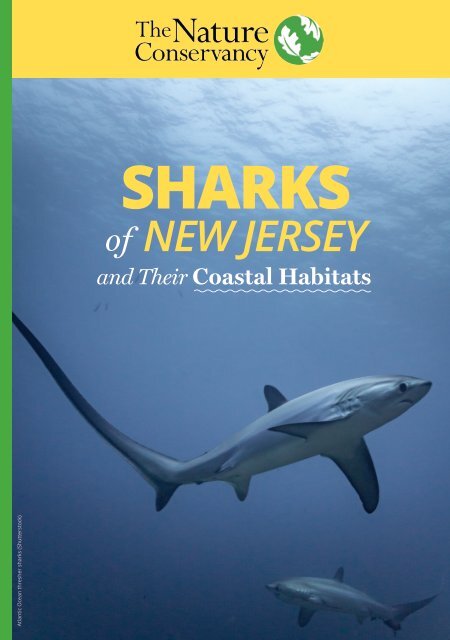2023_TheNatureConservancy_June_Digital_Issue
The Nature Conservancy invites you to meet some of New Jersey’s most famous fish, learn how we are working to protect their Jersey Shore habitat, and find out what you can do to help. Happy summer to all, finned and flip-flopped!
The Nature Conservancy invites you to meet some of New Jersey’s most famous fish, learn how we are working to protect their Jersey Shore habitat, and find out what you can do to help.
Happy summer to all, finned and flip-flopped!
Create successful ePaper yourself
Turn your PDF publications into a flip-book with our unique Google optimized e-Paper software.
Atlantic Ocean thresher sharks (Shutterstock)<br />
SHARKS<br />
of NEW JERSEY<br />
and Their Coastal Habitats
Test Your<br />
SHARK<br />
IQ<br />
( A N D<br />
G E T A P LU S H TOY )<br />
How well do you know<br />
New Jersey’s sharks?<br />
Take our<br />
ONLINE QUIZ<br />
on shark facts!<br />
Everyone who takes<br />
the quiz through the<br />
end of Shark Week<br />
(July 18) is eligible to<br />
receive a plush shark<br />
toy (while supplies last).<br />
You must be over 18 years old to participate.<br />
Everyone Loves<br />
the Jersey Shore,<br />
Including Sharks!<br />
DID YOU<br />
KNOW?<br />
Sharks and humans<br />
share a common<br />
ancestor from 440<br />
million years ago,<br />
Gladbachus<br />
adentatus.<br />
A TRIO OF IMPORTANT SHARK<br />
SPECIES RELY ON NEW JERSEY’S BACK-BAY<br />
SALT MARSHES TO SURVIVE. Sand tiger<br />
sharks, sandbar sharks and smooth dogfish<br />
all give birth in coastal estuaries, like<br />
Barnegat Bay and Great Bay, behind New<br />
Jersey’s barrier islands. Juvenile sharks<br />
(called pups) spend their first few months<br />
eating, growing and learning to be sharks<br />
in the protected, resource-rich habitats.<br />
Sharks benefit from healthy coastal<br />
habitats and in return play a vital role<br />
in marsh function and biodiversity<br />
balance. Sharks strengthen the gene pool<br />
and health of their prey populations,<br />
including fish, mollusks and crabs, and<br />
help maintain the integrity of seagrass<br />
beds and reefs. When young sharks<br />
finally venture into the Atlantic, they<br />
keep the food chain balanced in the other<br />
direction, serving as possible meals for<br />
apex ocean cousins like great whites<br />
and makos.<br />
Now, if sharing coastal waters with<br />
sharks gives you a shiver, remember: we<br />
have coexisted with them peacefully for<br />
thousands of years. Though Hollywood<br />
portrays sharks as man-eating menaces,<br />
the reality is actually much scarier for the<br />
sharks than for us. Globally, 100 million<br />
2 The Nature Conservancy
RESTORATION PROJECT<br />
The Nature Conservancy<br />
is working to restore New<br />
Jersey’s coastal salt marsh<br />
habitats, including at a<br />
project site behind Avalon.<br />
Practical<br />
NJ Perspective<br />
Shark incidents in New<br />
Jersey are extremely rare.<br />
A mere five shark-related<br />
fatalities have occurred here<br />
since recording began in the<br />
1800s, and four of those are<br />
attributed to the anomalous<br />
rogue attacks of 1916 that<br />
sparked the Jaws book and<br />
movie; the last happened<br />
in 1926. There have only<br />
been 50 recorded shark<br />
encounters in New Jersey<br />
waters since 1884, and half<br />
of those were provoked<br />
by humans. Rip currents,<br />
lightning strikes, fireworks<br />
accidents and commercial air<br />
travel are each exponentially<br />
deadlier than sharks at<br />
the Jersey Shore.<br />
George Steinmetz<br />
sharks perish every year, harvested by people for parts or as<br />
unintended fishing bycatch, while the average annual tally of<br />
fatal shark incidents worldwide is fewer than ten.<br />
SHARKS ARE STRATEGIC ENVIRONMENTAL INDICATORS.<br />
If they are thriving, then the habitats they live in—which are<br />
also critical for people—are healthy. But shark populations have<br />
declined by 71 percent since the 1970s, and 75 percent of shark<br />
species are at risk of extinction. What does this say about the<br />
direction our planet is headed? A world without sharks is a very<br />
scary narrative.<br />
There is reason for hope, though. We can protect and restore<br />
habitat upon which sharks rely to give them the best chance at<br />
survival. And, because sharks are an umbrella species, efforts<br />
to help them have a ripple effect to other marine life, from<br />
stingrays to migratory shorebirds to diamondback terrapins.<br />
In the following pages, THE NATURE CONSERVANCY invites you<br />
to meet some of New Jersey’s most famous fish, learn how we<br />
are working to protect their Jersey Shore habitat, and find out what<br />
you can do to help. Happy summer to all, finned and flip-flopped!<br />
Sand Tiger Shark<br />
Sandbar Shark<br />
Smooth Dogfish<br />
Illustrations: Alexander LeBron<br />
nature.org 3
Movers and Shakers of<br />
New Jersey’s Salt Marshes<br />
SANDBAR Shark<br />
Carcharhinus plumbeus<br />
Slender and gray-brown to bronze, with a classic<br />
triangular dorsal fin and white belly, adults<br />
can reach up to 8 feet long. Long, rounded<br />
snouts open to reveal wide, triangular,<br />
serrated upper teeth and<br />
narrow lower teeth.<br />
up to 8 FEET LONG<br />
Shutterstock<br />
HABITAT<br />
True to their name, they frequent<br />
waters over sandbars, favoring shallow<br />
bays and harbors. Locally, sandbar<br />
sharks are known to reproduce and<br />
mature in Barnegat Bay,<br />
Great Bay and<br />
Delaware Bay.<br />
DIET<br />
Sandbar sharks are opportunistic<br />
bottom-feeders that prey primarily<br />
on small fish, mollusks (squid is a favorite)<br />
and crustaceans. In New Jersey’s back bays<br />
and marshes, pups often feed on<br />
blue crabs.<br />
SAY CHEESE<br />
Sandbar sharks are the most commonly seen<br />
toothed shark in New Jersey’s coastal bays.<br />
4 The Nature Conservancy
THE SHARKS THAT LIVE AND REPRODUCE<br />
IN NEW JERSEY’S COASTAL WETLANDS tend to be<br />
smaller than many of their relatives and do not have<br />
a history of harming humans. Females visit our back<br />
bays, give live birth to their offspring, and continue<br />
on their way. Pups receive no maternal care and rely<br />
on the marsh habitat to hide, feed and grow for<br />
several months before venturing into the Atlantic.<br />
Many will return to the same back bay for their<br />
second summer.<br />
SAND TIGER Shark<br />
Carcharhinus taurus<br />
These large sharks have<br />
robust, muscular bodies<br />
of light brown or gray<br />
color. They can grow to<br />
nearly 11 feet and weigh<br />
300 pounds! Their<br />
mouths are distinctively<br />
menacing-looking, with<br />
large, pointed teeth that<br />
visibly protrude even<br />
when closed. Despite<br />
their aggressive name<br />
and appearance, sand<br />
tigers are docile by<br />
nature and, because<br />
their bite radius is<br />
too small to cause a<br />
human fatality, not<br />
considered a<br />
threat to people.<br />
HABITAT<br />
The surf zone, shallow bays,<br />
and coral or rocky reefs.<br />
Great Bay and<br />
Delaware Bay are nursery<br />
areas for sand tiger sharks.<br />
DIET<br />
Sand tigers will dine on<br />
large and small bony fish,<br />
rays, squid, crustaceans and<br />
smaller sharks (Look out,<br />
smooth dogfish!).<br />
Shutterstock<br />
up to 300 POUNDS and 11 FEET LONG<br />
IT JUST POPPED UP TO SAY HELLO<br />
For buoyancy while hunting, sand tigers gulp air at the water’s surface to inflate<br />
their stomachs. Sometimes they take in too much air and need to release it. Burp!<br />
nature.org 5
New Jersey’s Salt Marshes<br />
SMOOTH DOGFISH<br />
Mustelus canis<br />
Small, slender sharks with gray or tan upper bodies<br />
and white bellies, they grow up to 3 feet long. Despite<br />
a canine name, they are distinguishable by<br />
narrow, cat-like eyes located in<br />
front of their spiracles, head openings<br />
through which they draw<br />
water over their gills.<br />
Annie Guttridge<br />
up to 3 FEET LONG<br />
6 The Nature Conservancy<br />
NOM NOM NOM<br />
Unlike most sharks that have sharp,<br />
blade-like teeth, the smooth dogfish<br />
has tiny, flat, blunt teeth to<br />
crush their (often crunchy) prey.<br />
HABITAT<br />
Preferring shallow conditions (less than 60<br />
feet deep), these sharks commonly reside on<br />
continental shelves and in bays and other<br />
inshore waters. Some individuals will eschew<br />
the ocean and spend their entire lives in calm<br />
estuaries. In New Jersey, Great Bay<br />
and Little Egg Harbor are known<br />
smooth dogfish nurseries.<br />
DIET<br />
Crustaceans, squid,<br />
small shellfish and<br />
small bony fish<br />
make up the majority of<br />
the smooth dogfish diet.
Who Are the<br />
Species in the<br />
Neighborhood?<br />
THERE ARE AS MANY OR MORE CHARACTERS<br />
living in New Jersey’s salt-marsh communities as<br />
there were in Sesame Street’s famous 1969 song. Take<br />
a look at just a few of the many species that, along<br />
with sharks, play important roles in the ecosystem.<br />
1. SHORTFIN SQUID<br />
Illex illecebrosus<br />
During their one-year lifespan, squid eat<br />
fish, crustaceans and…other squid! Up to<br />
12 inches long, they are mostly orange<br />
with a brown stripe, but can also regulate<br />
their body color.<br />
2. SUMMER FLOUNDER OR FLUKE<br />
Paralichthys dentatus<br />
Flounder graduate from eating tiny,<br />
floating zooplankton in their larval stage<br />
to snapping up small fish and crustaceans<br />
as adults. As they mature, they also<br />
metamorphosize so that both eyes face up<br />
on the left side of the body. These flatfish<br />
live up to 14 years, grow up to 3 feet long,<br />
and can change their color to blend in with<br />
the sediment in which they burrow.<br />
3. SPINY BUTTERFLY RAY<br />
Gymnura altavela<br />
A diet of fish and squid allows these<br />
graceful underwater flyers to grow to a<br />
wingspan of more than 7 feet, with skin<br />
featuring intricate, marbled patterns.<br />
4. BLUE CRAB<br />
Callinectes sapidus<br />
Blue crabs have paddle-like hind legs for<br />
swimming and special shell pigments that<br />
create their unique hue. Males (jimmies)<br />
and mature females (sooks) will eat<br />
almost anything, including clams, oysters,<br />
mussels, smaller crustaceans, and<br />
decaying fish, animals or plants.<br />
They can live up to eight years.<br />
5. ATLANTIC MENHADEN<br />
Brevoortia tyrannus<br />
The name of this herring-family fish<br />
comes from the Wampanoag word<br />
munnawhatteaug, roughly translating to<br />
“fertilizer” for the role they have played<br />
in crop production. These filter feeders<br />
primarily consume plankton to grow into<br />
a classic fish shape up to 15 inches long<br />
and live up to 12 years.<br />
6. HARD CLAM<br />
Mercenaria mercenaria<br />
Also known as the Northern quahog,<br />
these plankton eaters can live up to<br />
30 years and grow as long as 4<br />
inches. Their dormancy and breeding<br />
cycle is heavily dependent on water<br />
temperatures, making them susceptible<br />
to climate changes.<br />
1<br />
2<br />
5 Shutterstock<br />
6<br />
3<br />
Shutterstock<br />
4<br />
NOAA Ocean Exploration<br />
Dennis Rabeling<br />
Christopher S. Wood<br />
Shutterstock<br />
nature.org 7
Ocean<br />
Occupants<br />
NEW JERSEY’S ATLANTIC OCEAN<br />
coastline is home to shark-species heavyhitters<br />
that are larger and faster, with bigger teeth and<br />
(perhaps) more familiar names. Like all sharks, their<br />
skeletons are made from cartilage, and they have multiple<br />
water-filtering gill slits on the sides of their heads. Unlike their<br />
smaller counterparts, they will attempt to hunt larger, more varied<br />
prey, including sea turtles and seals. Humans are not on their mostwanted<br />
list, though. Bites are extremely rare (a 1-in-3.8 million chance)<br />
and are usually cases of mistaken identity (surfers look like seals).<br />
Norbert Probst<br />
Shutterstock<br />
A few things that are<br />
statistically deadlier<br />
than sharks (and even<br />
shark incidents that<br />
do happen have an<br />
89 percent survival rate):<br />
CHAMPAGNE CORKS<br />
ICICLES<br />
COCONUTS<br />
LADDERS<br />
BATHTUBS<br />
ASTEROIDS<br />
Shortfin<br />
Mako Shark<br />
Isurus oxyrinchus<br />
Brilliant metallic blue coloration<br />
and a pointy snout characterize<br />
this apex predator, which grows<br />
up to 12 feet long and weighs up to<br />
1,200 pounds.<br />
HABITAT: The open ocean is the<br />
domain of makos, which very<br />
rarely approach coasts. Like<br />
many other sharks, this species<br />
is endangered in New Jersey and<br />
regional waters due to overfishing.<br />
DIET: Squid and larger bony fish<br />
like mackerel, tuna and swordfish<br />
make up most mako meals, but other<br />
sharks, dolphins, turtles and seabirds<br />
may also be on their menu.<br />
FUN FACT: ZIP-A-DEE-DOOH-DAH<br />
Reaching swimming speeds of 45<br />
miles per hour, makos are not only<br />
the fastest sharks, but also some of<br />
the swiftest fish on the planet. They<br />
are also known for leaping 20-30 feet<br />
out of the water while hunting.<br />
8 The Nature Conservancy
Atlantic Common<br />
Thresher Shark<br />
Alopias vulpinus<br />
The hallmark of these slender sharks is<br />
their long tail (caudal) fins, which measure<br />
roughly half the total length of their bodies.<br />
Their bellies are white, while the rest of their<br />
bodies range from brown to gray.<br />
HABITAT: Inhabiting coastal and deep ocean waters<br />
alike, they are familiar fish in New York Harbor<br />
and along New Jersey’s shoreline.<br />
DIET: Threshers are near the top of the<br />
food chain. They mostly eat herring,<br />
mackerel and other schooling fish,<br />
but will occasionally pursue smaller<br />
sharks, squid and seabirds.<br />
FUN FACT: SLAP HAPPY<br />
Threshers use their tails like whips<br />
to slap and stun fish and other prey<br />
long enough to devour them.<br />
More than 450 shark<br />
species inhabit the<br />
world’s oceans.<br />
Additional types<br />
found in the Atlantic<br />
near New Jersey include:<br />
HAMMERHEADS<br />
(great, scalloped and smooth)<br />
BLUE SHARK<br />
PORBEAGLE<br />
BASKING SHARK<br />
TIGER SHARK<br />
DUSKY SHARK<br />
BULL SHARK<br />
NURSE SHARK<br />
LEMON SHARK<br />
BLACKTIP SHARK<br />
SPINNER SHARK<br />
OCEANIC WHITE TIP SHARK<br />
Shutterstock<br />
Great White Shark<br />
Carcharodon carcharias<br />
Very large sharks with gray, torpedo-shaped<br />
bodies and white bellies,<br />
pointy snouts, and sizeable<br />
mouths filled with rows of<br />
razor-sharp teeth.<br />
HABITAT: Warmer coastal waters<br />
in the south are their preference,<br />
but they appear regularly along<br />
the coast of New Jersey. In 2016, a<br />
great white nursery was discovered<br />
in the New York Bight, an area<br />
along the Atlantic Coast that<br />
extends from Cape May Inlet in<br />
New Jersey to Montauk Point on<br />
the eastern tip of Long Island,<br />
New York.<br />
DIET: Juveniles feed on fish,<br />
including other sharks, and rays.<br />
Adults prefer marine mammals<br />
like seals, sea lions, porpoises,<br />
dolphins and small whales, but<br />
will eat sea turtles, squid and fish.<br />
They have also been known to<br />
scavenge on whale carcasses.<br />
FUN FACT: PING PONG<br />
Great white sharks are the<br />
largest predatory fish in the<br />
world, reaching up to 21 feet<br />
long and 4,300 pounds. It is not<br />
unusual for tagged great whites—<br />
sometimes with amusing names<br />
like Mary Lee (who has her own<br />
Twitter account), Ironbound and<br />
Maple—to “ping” sensors off the<br />
coast of New Jersey.<br />
nature.org 9
TO THE RESCUE<br />
“Beneficial use” is an<br />
innovative technique to<br />
restore coastal salt marshes.<br />
Clean sediment dredged<br />
from clogged boat channels<br />
nearby is sprayed from a<br />
water cannon over degraded<br />
sections of marsh to raise<br />
elevation and give drowning<br />
grasses a foothold.<br />
TNC<br />
Help the Shore’s<br />
Unsung Heroes<br />
NEW JERSEY’S 200,000 ACRES OF<br />
COASTAL WETLANDS ARE THE UNSUNG HEROES<br />
OF THE JERSEY SHORE. They provide critical<br />
habitat for sharks, fish and birds, they protect<br />
human communities, and they help drive the<br />
economy through recreation and fishing.<br />
But many of New Jersey’s salt marshes are<br />
eroding and drowning due to accelerating<br />
sea-level rise, boat wakes and hardened<br />
shorelines. If the grassy expanses we see from<br />
the Garden State Parkway and as we cross<br />
bridges to our favorite beach towns continue to<br />
degrade unchecked, they will no longer provide<br />
nurturing resources for sharks and other species,<br />
or protect coastal communities.<br />
THE NATURE CONSERVANCY is using<br />
innovative, natural solutions to help sustain salt<br />
marshes. At three sites including state-owned<br />
marshes behind Avalon, TNC and partners<br />
boosted degraded sections of marsh with clean<br />
mud dredged from nearby clogged boat channels<br />
George Steinmetz<br />
Back bay marshes in Avalon were among three<br />
New Jersey locations where TNC and partners<br />
tested beneficial use, with promising results.<br />
to raise elevation and create conditions for grasses<br />
to flourish. Promising results have encouraged us<br />
to promote expansion of the approach for other<br />
sites while advocating for additional policies that<br />
protect and restore New Jersey’s coastal habitats<br />
for people and wildlife.<br />
We launched the NJ Bay Island Restoration<br />
Planner, a free online tool, to empower users with<br />
data to assess degraded marsh islands and match<br />
them with dredging needs. And, we are leading<br />
education through the Beneficial Use Learning<br />
Network to hasten the pace of marsh restoration<br />
and help keep marshes in place for all of the<br />
creatures that depend on them.<br />
10 The Nature Conservancy
CATCH AND RELEASE<br />
Monmouth professor Keith<br />
Dunton releases a tagged<br />
sandbar shark back into the bay.<br />
New Jersey<br />
Shark School<br />
TO BETTER COMPREHEND HOW SHARKS<br />
USE COASTAL ESTUARY HABITATS IN NEW JERSEY,<br />
TNC has teamed up with Monmouth and Rutgers<br />
Universities to track and study the abundance<br />
and movement of species in Great Bay and Little<br />
Egg Harbor, focusing on sandbar and sand tiger<br />
sharks. The project uses a system of acoustic tags<br />
and underwater sensors (like E-ZPass) to collect<br />
important shark data.<br />
Keith Dunton, associate professor of biology at<br />
Monmouth University, who leads the initiative,<br />
has a special interest in shark research. “We know<br />
generally that these shark species give live birth to<br />
pups in the bay, and that juveniles spend the first<br />
few months growing here before heading out to the<br />
TNC<br />
What You Can<br />
Do to Help Sharks<br />
• Don’t consume food<br />
containing shark parts.<br />
• Don’t use beauty or health<br />
products that contain<br />
shark-derived ingredients<br />
like squalene (shark liver oil).<br />
• Reduce your use of plastics<br />
that often end up in the<br />
ocean and can harm wildlife.<br />
• If you eat tuna or other fish<br />
products, buy sustainablysourced<br />
brands certified<br />
by the Marine Stewardship<br />
Council.<br />
• Don’t catch sharks. If you<br />
do by mistake, make sure<br />
to return them unharmed.<br />
• Support organizations<br />
that conserve and protect<br />
marine habitats.<br />
• Support nature-friendly<br />
policies at the voting booth.<br />
• Educate yourself about<br />
sharks and share your<br />
insights with friends<br />
and family.<br />
• Volunteer for a beach or<br />
bay cleanup.<br />
ocean,” he says. “But it is important to get a more<br />
detailed picture of how sharks use New Jersey’s<br />
habitats—and where they go when they swim out<br />
to the Atlantic—so we know what to prioritize for<br />
their conservation management.”<br />
New Jersey’s coastal marshes, which are<br />
critical ecosystems that support sharks and<br />
the creatures that make up their diet, are<br />
close to populated mainland, where pollution,<br />
overfishing, noise, sedimentation and other<br />
challenges are intensified. Erosion from storms<br />
and inundation from a rising sea contribute to<br />
the degradation of these grassy expanses.<br />
“It would be a massive blow to the shark<br />
population to lose the salt marshes in New Jersey,<br />
throwing the food chain and ecosystem out of<br />
balance,” says Dunton. “Our partnership study<br />
will help inform how we can best support these<br />
species, and healthy and strong estuaries will<br />
play a big part.”<br />
nature.org 11
Like what you’ve read?<br />
Keep up with nature in<br />
New Jersey by subscribing to<br />
TNC’s FREE MONTHLY<br />
E-NEWSLETTER!<br />
Smooth dogfish (© Keith Cowley/Living Sharks Museum)<br />
Test Your<br />
SHARK<br />
IQ<br />
( A N D<br />
G E T A P LU S H TOY )<br />
200 Pottersville Road, Chester, NJ 07930<br />
nature.org/newjersey<br />
newjersey@tnc.org<br />
908-879-7262<br />
@NJconservancy<br />
@nature_NJ<br />
@nature_NJ<br />
@nature_NJ<br />
How well do you know<br />
New Jersey’s sharks?<br />
Take our<br />
ONLINE QUIZ<br />
on shark facts!<br />
Produced for The Nature Conservancy by<br />
62 media group, 62 Elm Street, 3rd Floor,<br />
Morristown, NJ 07960-4110, 973-539-8230<br />
Everyone who takes<br />
the quiz through the<br />
end of Shark Week<br />
(July 18) is eligible to<br />
receive a plush shark<br />
toy (while supplies last).<br />
You must be over 18 years old to participate.
















